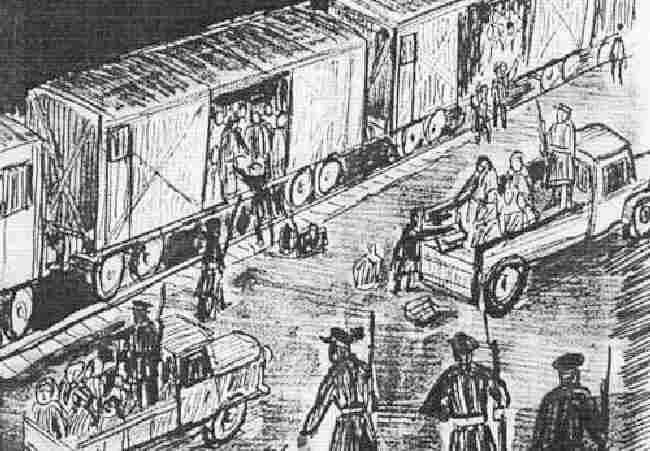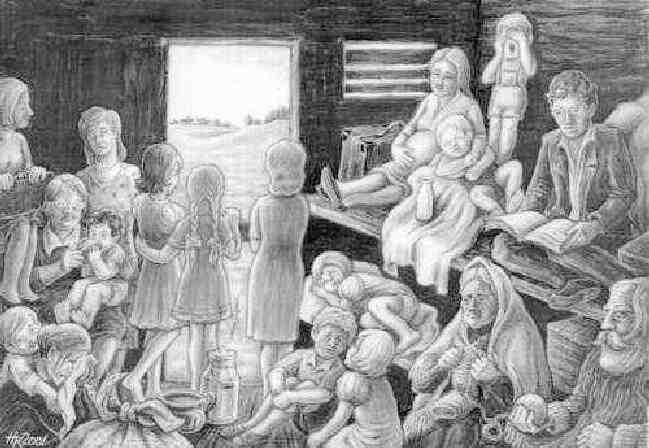
World War II: Soviet Deportation of Estonians (1941)

Figure 1.--Hilda Orn was deported from Narva June 14, 1941. She recalls how her famoly was loaded into railway cars. Her father, engineer August-Heinrich Orn (born 1890) died in Sevurallag Fecember 22, 1941. His death only a few months later destifies to the terrible conditions in the camp. Her mother Hilda-Rosalia (born 1902) and daughter Heljo (born 1924)suffered from the primitive living conditions at the "forced settlement" in Tomsk Oblast, Vasjugan Region, village of Vesjolõi. The family was released from settlement as a result of the Se-Staminization effort in 1956. The drawing here is from her books: H. Orn, "Ka see oli elu" (This Was Life Too). If we fine a web page with purchase information we will make a link.
|
We have some information about the Soviet deportations, although there is still much that we do not understand. Estonians who were deported have provide detailed discriptions of their experiences. Few of those who were arrested survived the dreadful camps, but about half of the deportees did survive and eventually returned to Estonia. As a result, there are many discriptions of what occurred. The accounts are heart rending. Unlike the Holocaust, there are no known photographs of the arressts and transports. There are, however, images from the settlements around the camps. Much of the process was similar to the Holocaust with the exception that conditions in the transports were not as horific and of course gas chambers did not await the Soviet deportees.
Photographs
Unlike the Holocaust, there are virtually no photographs of the Soviet deportations. This in itself is interesting. This is not only the case for the Soviet deportments from Estonoia, but from Latvia, Lithuania, Poland, Chechnya, and other areas. It is not diffult to see why the Soviets did mnot want images taken. The immsages from the Holocaust are overpowering. What is interesting is that even though the NAZIs also did not allow photography, there are many images. Many were taken by the NAZIs involved in the operation. We are not sure why there was such a difference. We suspect that part of the reason is that NKVD officers took such directives much more seriously than the SS and other NAZIs involved in the Holocaust, many of whom were proud of their work. The only images of the Soviet deportations are drawings by some of the deportees. A number of detailed drawings were done by Koppel-Kohhandi. There are, however, NKVD mug shots of those arrested. I do not think whole families had mug shots taken, only those arrested. There are also photographs taken in the settlements around the camps.
Arrests
We do not know when the arressts began or how they were timed. We do not know if actions were taken against their families before June 14, 1941.
Timing
We mote that large numbers of Estonians were deported on June 14. We do not know if any substantial number of Estonians were deported before this time. The June 14 action appears to have been a large scale action planned sometime in advance. It occurred about a week before the NAZI invasion. We do not know if there was any connection. The NAZI invasion certainly surprised Stalin. so the two events do not appear to have been coinnected. The NKVD, however, was not as surpised as Stalin.
Selection
We do not know precisely how the deportees were seleccted. There were certain categories of people that NKVD targetted for arrest. Especially high on the Soviet list were government officials, police officers, and army officers. Their families would have been targets for deportation. Others probably included politicans, teachers, writers, publishers, and anyone who had been critical of the Soviets. Anyone participating in demonstrations against the occupation were obvious subjects for arrest or deportation. What is not entirely clear to us is why whole families were tatgetted. Perhaps terror was part of the reason. Stalin certainly thought that if an individual was suspect so was his family likely to be unreliable.
Collection
We are not sure how the deportees were collected. Nor do we know if the NKVD showed up at their door in a surprise action or if the deportees were given any advanced notice. We are unsure as to what the deportees were permitted to take with them. We do know that they were able to take some possessions. We do not know what they were limired to and how much time they were given to pack. The drawing here shows the deportees arriving with a few suitcases (figure 1). Images from the deportees after arriving at their destination shows then with bundles. The deportees appear to have been collected and driven to rail lines by open truck under armed guard.

Figure 2.-- Baltic islanders here are depicted in one of the depotment railway cars in 1941. The drawing was made by Helvi Koppel-Kohandi. The open door gives a misleading impression. Perhaps it is at a stop. Normally I think that the doors were locked shut.
|
Transport
The deportees were transported in enclosed cargo cars. One source estimates that there were on average about 22 people per car. A hole was cut in the floor to serve as a toilet. The railway cars had bars on the windows and the cars were locked from the outside and the trains had armed uniformed guards. There were men's cars. They were mostly for the heads of family that had been arrested. Lists were prepared during transit or at the point of delivery. Most of these lists, however, are in Russian making it difficult to dechipher the actual Estonian names.
Destination
The deportees were tansported to various places of forced settlement. Many of thedestinations were in the far north, regions that were unsettled. Conditions were rough because of the far northern locations and isolation. The deportees were brought to these locations as settlers needed to tap the resources through mining, forestry, and other activities.
While we know of no photographic images of the deportations, there are some images of the deportees once they reached their destinations. This is because some deportees brought cameras. No one dared to use their camer during the collection and loading of te railway cards. There were armed guards and using a camera would have meant losing it and perhaps arrest. One at the destination , security conditions seem more relaxed. We mote the deportees with their bundles.
The initial years were times of great hunger and misery. I am a little unclear as to the situation and conditions. Those who were arrested lived in prison camps. Conditions there were dreadful and most died within a few much of arrival, especially during the Winter. I think but am unsure that the families lived in nearby settlements. The families at first seem to have lived in baracks and latter small cottages. The arrested individuals were involved in hard mannual labor, essentially as slaves. The adult family members despiye their skills are education were also employed in mannual labor. Presumably they were paid, but I have few details. I do not know to what exctent schools were set up for the children or at what age the young people were expected to begin working. We know that schools were operating by 1946. Deportees, however, had dificuly gaining acceptance to universities. Nor do I know to what extent the arrested individuals in the camps were allowed contact with their family in the nearby settlements.
Escape
Some young people managed to escape back to Estonia. Many of these because thay did not have residency carsa were rearrested and sent via various prisons and camps to back to their former places of settlement, in some cases back to their mothers if they were still alive. In the Soviet system, deportation was similar to a prison term. You had to apply and receive relaease from deportment status.
Sources
Kistler-Ritso Estonian Foundation. (We used an article in their web site, but I am nor sure who the author was or what the title of the article was.)
Walter, Hannes "Estonia in World War II", webpage accessed April 9, 2004.
HBC

Navigate the Boys' Historical Clothing Web Site:
[Return to Main Soviet occupation of Estonia page]
[Return to NAZI-Soviet Non-agression Pact page]
[Return to the Main Soviet deportation page]
[Introduction]
[Activities]
[Biographies]
[Chronology]
[Clothing styles]
[Countries]
[Bibliographies]
[Contributions]
[FAQs]
[Glossaries]
[Satellite sites]
[Tools]
[Boys' Clothing Home]
Created: April 10, 2004
Last updated: April 14, 2004




